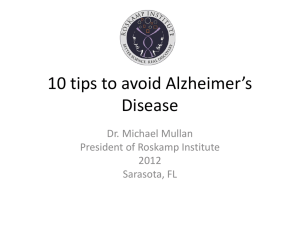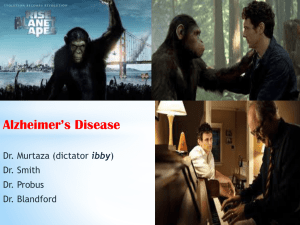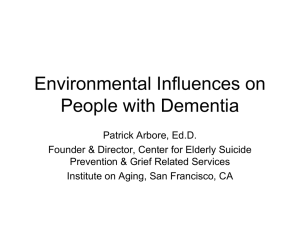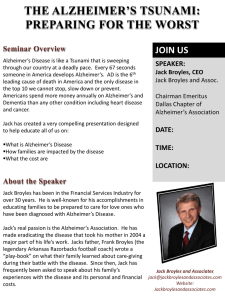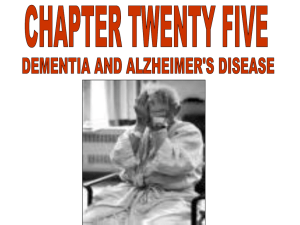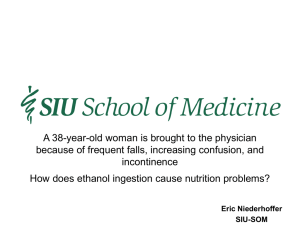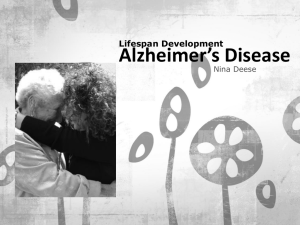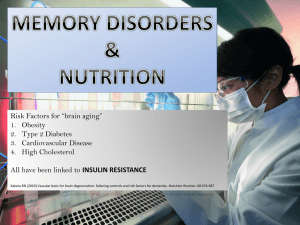2/26/13 FAAFM Webinar Powerpoint Presentation
advertisement
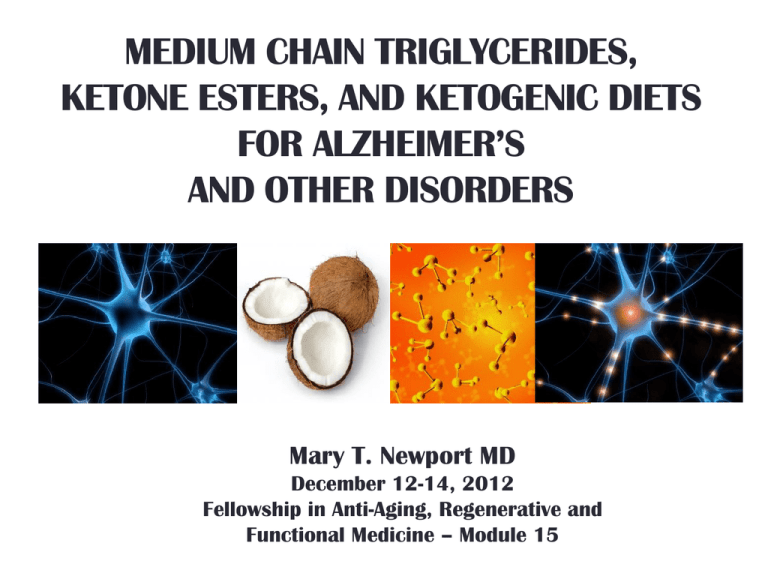
MEDIUM CHAIN TRIGLYCERIDES, KETONE ESTERS, AND KETOGENIC DIETS FOR ALZHEIMER’S AND OTHER DISORDERS Mary T. Newport MD December 12-14, 2012 Fellowship in Anti-Aging, Regenerative and Functional Medicine – Module 15 Alzheimer’s Facts and Figures According to the Alzheimer’s Association*: • 5.4 million people in the USA alone have Alzheimer’s (AD) and • • • • • predicted to be 15 million in USA by 2050, and100 million worldwide 1 in 8 older Americans has AD More than 200,000 under age 65 have “early onset” AD Nearly half of people over age 85 have AD While deaths from stroke, heart disease, and certain cancers declined between 2000 and 2006, deaths from AD increased by 47.1% Cost of care to government and businesses estimated $200 billion and equivalent of $210 billion unpaid caregiving *2012 Alzheimer’s Disease Facts and Figures Report from Alzheimer’s Association Plaques and Tangles 100 billion nerve cells. 100 trillion synapses. Dozens of neurotransmitters. Brain tour from Alzheimer’s Association, alz.org. Blennow K, MJ de Leon, H Zetterberg. “Alzheimer's disease.” The Lancet, Vol. 368 No. 9533 (2006): 387 - 403 PNAS 2008 105 (9): 3171-3172 4 – 8 month old WT 18 month old WT 11.9 month old APP23 18 month old APP23 12 month old APP23 18 month old APP23 Beta Amyloid PET Scan • Alzheimer's disease on the horizon? PET scans revealed beta-amyloid plaque in the brains of three Alzheimer's disease patients (left) and three normal controls (right). The yellow indicates high uptake of a label that targets beta-amyloid plaque, and the red indicates medium uptake. Dan Krotz. “New Clue in the Search to Predict Alzheimer’s Disease.” Berkley Lab News Center, December 16, 2008 Brain metabolism and Alzheimer’s In 1970, Dr. Siegfried Hoyer reported decreased glucose levels & lower cerebral metabolic rate in brains of some people with dementia. By 2004, proposed decreased brain metabolism results in diminished production of acetyl CoA and ATP, required for synaptic activity and plasticity. Siegfried Hoyer. “Brain metabolism and the incidence of cerebral perfusion disorders in organic psychoses.” Deutsche Zeitschrift für Nervenheilkunde 1970 ,197 (4): 285-92 Hoyer S: Causes and consequences of disturbances of cerebral glucose metabolism in sporadic Alzheimer disease: therapeutic implications. Adv Exp Med Biol 2004, 541:135-152 Brain metabolism and Alzheimer’s In 1991, Hoyer reported that: • There is a shift in the types of fuel used by the brain in people as they age that is even more prominent in people with AD • Young normal people use fuel in the cerebrum in ratio of 100:1 of glucose to alternative fuels • Elderly persons without Alzheimer’s, this ratio is 29:1 • Early stages of Alzheimer’s this ratio is 2:1 • Suggested fuel for brain cells must come from alternative fuels, such as fatty acids and amino acids Hoyer S. “Abnormalities of glucose metabolism in Alzheimer’s disease.” Annals New York Academy of Sciences Vol. 640 (1991): 53-58 Alzheimer’s is “Type 3 Diabetes” Explosion of research into the relationship between AD and brain glucose metabolism in 1990’s and beyond. In 2005, De la Monte and Wands looked at brains of persons with advanced AD who did not have type 1 or 2 diabetes: • Levels of insulin and factors related to making and using insulin are greatly reduced. • All of the signalling pathways involved in the use of energy are abnormal. • The functioning of mitochondria is abnormal. • Coined term “type 3 diabetes” to describe insulin deficiency and insulin resistance in AD brain De la Monte SM, JR Wands. “Review of insulin and insulin-like growth factor expression, signaling, and malfunction in the central nervous system: Relevance to Alzheimer’s disease.” Journal of Alzheimer’s Disease Vol. 7 (2005): 45-61 Alzheimer’s is “Type 3 Diabetes” In 2008, de la Monte and Wands looked at various stages of AD brains in persons without type 1 or 2 diabetes: • Loss of insulin and neurons with insulin growth factor receptors begins early in the disease. • This worsens with each stage of the disease until it is very severe and occurs throughout the brain in most severe cases of AD. • Suggest that therapies for type 1 or 2 diabetes may be beneficial. • Intranasal Insulin • Metformin or other medications for type 2 diabetes De la Monte SM, JR Wands. “Alzheimer’s disease is type 3 diabetes – evidence reviewed.” Journal of Diabetes Science and Technology, Vol. 2 No. 6 (November 2008): 1101-1113 FDG-PET scans show decreased glucose uptake NORMAL BRAIN ALZHEIMER’S BRAIN Alternative Fuels for AD • Glucose is the primary and preferred fuel for most cells, including brain. • Humans are programmed by evolution to switch to use of alternative fuels during starvation when glucose stores have been used up • Amino acids (Gluconeogenesis) • Fatty acids • Ketones • Lactate • Supplying an alternative fuel could bypass problem of insulin deficiency and insulin resistance in AD brain O. E. OWEN, A. P. MORGAN, H. G. KEMP, J. M. SULLIVAN, M. G. HERRERA, AND G. F. CAHILL, JR. “Brain Metabolism during Fasting” The Journal of Clinical Investigation Vol. 46, No. 10, 1967 First report of ability of brain to use ketones as fuel • Obese nurse given only water, vitamins, and salt tablets for a period of forty-one days. • Sampled blood from catheters in arteries and veins around her brain and liver. • Her brain survived this lengthy period of starvation by using ketones and by greatly reducing the use of glucose. • 2/3 of fuel used by her brain was provided by the ketone bodies beta-hydroxybutyrate and acetoacetate Overnight in normal people: glucose 100% of fuel Starvation: Ketones about 2/3 of fuel Diagram from: Oliver E. Owen. “Ketone Bodies as a Fuel for the Brain during Starvation,” Biochemistry And Molecular Biology Education Vol. 33, No. 4, 2005:246–251 FIG. 3. Concentrations of ketone bodies and free fatty acids during starvation in humans. Values are shown as the means S.E. Ketone bodies undergo the greatest changes of all fuels during total starvation. Diagram from: Oliver E. Owen. “Ketone Bodies as a Fuel for the Brain during Starvation,” Biochemistry And Molecular Biology Education Vol. 33, No. 4, 2005:246–251 3 obese college students starved until β-OH B levels increased Given insulin to drive blood glucose into hypoglycemic range Developed none of usual symptoms of hypoglycemia: Brain is protected from hypoglycemia by ketone bodies. Diagram from: Chapter 26 - Alternative Fuel Utilization by Brain, George F. Cahill, Jr. & Thomas T. Aoki from Cerebral Metabolism and Neural Function (1980) Ketone Bodies Dietary maneuvers can produce ketosis: • Starvation or fasting • Ketogenic diet • Medium chain fatty acids (MCFAs) absorbed directly into portal vein and converted in liver to ketone bodies • Ketone esters, 1,3-D-Butanediol SS Bergen, Jr., Hashim SA, VanItallie TB “Hyperketonemia induced in man by medium-chain triglyceride,” Diabetes Vol. 15 No. 10 (1966): 723-725 ATP Adapted by Joanna Newport KETOGENIC DIET • Reported positive effects of ketogenic diet: • Epilepsy • Alzheimer’s disease • Parkinson’s disease • Lou Gehrig’s disease (ALS) • Traumatic brain injury and stroke • Oxygen toxicity • Glioblastoma • Weight loss Ketones Protect Neurons Dr. Richard L. Veech • “Addition of 4 mmol D-b-hydroxybutyrate protected cultured mesencephalic neurons from MPP1 toxicity [Parkinson’s model] and hippocampal neurons from Ab1–42 toxicity [Alzheimer model].” • “Ability of ketone bodies to protect neurons in culture suggests that defects in mitochondrial energy generation contribute to the pathophysiology of both brain diseases.” • “Ketone bodies may play a therapeutic role in these most common forms of human neurodegeneration.” Y Kashiwaya, T Takeshima, N Mori, K Nakashima, K Clarke, and RL Veech, “D-b-Hydroxybutyrate protects neurons in models of Alzheimer’s and Parkinson’s disease,” PNAS May 9, 2000, 97(10): 5440-5444 Ketone Ester • Richard L. Veech, MD, D Phil, NIH, Rockville, MD, began developing ketone body product in late 1990’s • Filed first patent application to develop therapeutic ketone body in 1998. • After at least a dozen variations, successfully synthesizes an ester of (R)-3-hydroxybutyrate for oral or IV administration around 2006 • Can achieve levels equivalent to those that occur in ketogenic diet and in starvation without toxicity • Series of hypothesis papers proposing use for treatment of AD, other neurodegenerative diseases and traumatic brain injury • Parkinson’s study imminent “Hypothesis Paper: Ketone Bodies, Potential Therapeutic Uses,” RL Veech, B Chance, Y Kashiwaya, HA Lardy, and GF Cahill, Jr., IUBMB Life, 51: 241–247, 2001 AC-1202 -- MCT Oil for AD Samuel Henderson, Ph.D. files first patent application for use of MCT oil to treat Alzheimer’s disease in 2000: • Insight: Mild ketosis produced by conversion of medium chain fatty acids to ketones in liver may be adequate to produce cognitive improvement in insulin resistant Alzheimer’s brain Medium Chain Triglycerides Converted to Ketones in Liver Medium Chain FAs also alternative fuel? • Medium chain fatty acids cross the blood brain barrier • MCFA feeding of lab rodents is associated with a substantial increase in mitochondrial oxidative capacity, which is sufficient to prevent lipid accumulation in this tissue. • MCFAs are oxidized in mitochondria of neurons and contribute to production of ATP (personal communication Dr. Henri Brunengraber). Turner N, K Hariharan, J TidAng, et al. “Enhancement of muscle mitochondrial oxidative capacity and alterations in insulin action are lipid species dependent: potent tissue-specific effects of medium-chain fatty acids.” Diabetes Vol 48 (2009): 2547–2554. AC-1202 Phase 2a Study - 2004 • 20 persons with mild to moderate AD given single dose tricaprylic acid (40 gm) vs. placebo on another occasion • On average, in nine ApoE4- persons ADAS-Cog improved by average of 6 points (of 75)and improved Paragraph Recall scores 90 minutes after just one dose; ApoE4+ as group did not improve; some individuals did improve. • β OHB levels increased to about 0.5 mmol/L Reger MA, ST Henderson, et. al.“Effects of b-Hydroxybutyrate on cognition in memory-impaired adults,”, Neurobiology of Aging, 2004,Vol. 25, 311-314 AC-1202 Phase 2b Study 2008 • 152 patients with mild to moderate AD received AC-1202 (containing 20 g MCT) or placebo for 90 days in a double-blind, randomized design • Mean change from Baseline in ADAS-Cog score on Day 45: 1.9 point difference, p = 0.0235 in ITT; 2.53 point difference, p = 0.0324 in per protocol; 2.6 point difference, p = 0.0215 in dosage compliant • ApoE4- patients taking AC-1202 differed from placebo by 5.73 points at Day 45 (p = 0.0027) and by 4.39 points at Day 90 and even more significant in dosage compliant patients. Samuel T Henderson*, Janet L Vogel, Linda J Barr, Fiona Garvin, Julie J Jones and Lauren C Costantini. “Study of the ketogenic agent AC-1202 in mild to Moderate Alzheimer's disease: a randomized, double-blind, placebo-controlled, multicenter trial,” Nutrition and Metabolism 2009 6(31): 1-25 AC-1202 Phase 2 trials • Similar results in Phase 2 trials in Age-Related Memory Impairment and in Elderly Dogs • Main adverse effect – diarrhea • Approved by FDA as “medical food” and marketed as prescription Axona in spring 2009 •May 2008 - 58 years old •Former accountant: can’t use computer , calculator , do simple math •Unable to read due to visual disturbance for 1 ½ years •Problems with word finding and spelling simple words •Doesn’t recognize certain relatives Steve Early Onset Alzheimer’s disease First symptoms 2001 ApoE4+ •Slow gait, unable to run •Jaw tremor and intention tremor •Distractible, takes things apart •Personality/sense of humor fading 12 DAYS BEFORE INTERVENTION May 9, 2008 Steve screened for bapineuzimab clinical trial in Tampa, Florida Met criteria, except scores 12 of 30 on MMSE (Study required score of 16) Scheduled appointment for May 21, 2008 to try again 1 DAY BEFORE COCONUT OIL INTERVENTION • May 20, 2008 • Steve screens for Eli Lilly clinical trial in St. Petersburg, FL • Scored only 14 of 30 on MMSE, needed 16 to qualify for study • Clock test– consistent with moderately severe Alzheimer’s 1st DAY OF COCONUT OIL INTERVENTION • May 21, 2008 - Steve receives 35 grams coconut oil with breakfast = 20 grams medium chain fatty acids (AC1202 dose) • Screened at Byrd Center for bapineuzimab clinical trial: • Scored 18 of 30 on MMSE • Qualified for study 1 Day Before Starting Coconut Oil 14 Days After Starting Coconut Oil 37 Days After Starting Coconut Oil Steve’s Clocks DAY BEFORE COCONUT OIL 14 DAYS ON COCONUT OIL 37 DAYS ON COCONUT OIL First Days after Coconut Oil Intervention • Begins daily consumption of coconut oil • Measured dose at breakfast, cooking and other coconut containing foods for lunch and dinner • More alert - Personality and sense of humor resurface • Steve says the “light switch came back on” and the “fog lifted” • Facial tremor no longer apparent • Intention tremor less apparent Between 0 - 2 months after Intervention Visual disturbance resolves Normalization of gait – able to run again Completes household and gardening tasks with minimal to no supervision and with less distraction His ability to initiate and continue a course of conversation improves Recognizes family members that he couldn’t recall one year earlier Family says he no longer looks lost, conversation makes sense [bHB] Plasma ketones & glucose vs time 0.3 [Glucose] 6 0.25 5 0.2 4 0.15 3 0.1 2 dinner 0.05 1 0 0 0 2 4 6 8 time (hr after breakfast) 10 DAY 51 – Levels after 35 Grams Coconut Oil with Breakfast and with Dinner 12 [Glucose] (mM) Plasma [ketone] (mM) [AcAc] Plasma [bHB] & [AcAc] after C-8 breakfast Plasma [bHB] & [AcAc] (mM) 1 bHB 0.45 1 AcAc 0.4 2 bHB 0.35 2 AcAc 0.3 0.25 0.2 0.15 0.1 0.05 0 0 0.5 1 1.5 2 2.5 3 time (hr) DAY 64 - Levels after 20 Grams Medium Chain Triglyceride Oil (C:8) ADAS-Cog and ADLs • On placebo for first 12 to 14 months of semagacestat trial • Cognitive testing nearly one year after starting MCFAs: • ADAS-Cog improved by 6 points on a 75 point scale from July 23, 2008 to May 9, 2009. Patients on place • Activities of Daily Living score improved by 14 points on a 78 point scale during that same interval. Stable MRI at 2 Years • 2004: “Normal” MRI • 2008: “Diffuse involutional change of the frontal and parietal lobes and moderate left-sided and severe rightsided amygdala and hippocampal atrophy with no ischemic change, which would support a clinical diagnosis of Alzheimer’s Disease • April 28, 2010 nearly two years after starting MCFAs: • “Stable MRI brain in comparison to prior examination dated 6/16/2008.” Percent 100 90 80 91 RESPONSES OF PERSONS WITH DEMENTIA AND OTHER MEMORY IMPAIRMENT TO MEDIUM CHAIN TRIGLYCERIDES N = 184 Mary T. Newport MD - September 2012 70 59 60 50 42 40 35 30 24 21 20 10 6 3 4 7 3 1 0 COMMENTS: The graph depicts responses of persons with dementias to oils containing medium chain triglycerides as reported by their caregivers. Reports were sent to MTN by email or letter and were spontaneous reports, not prompted with regard to specifics of response. Specifics of the responses were then categorized for purpose of this graph. Of the 184 individuals there were 84 males,99 females, 1 unknown; 125 of 184 reported age with range of 44 to 95 years old (average 72.5.) The positive response is presumably due to metabolism of medium chain triglycerides to ketone bodies for use by neurons as an alternative fuel in cells with decreased Improvements were generally categorized as follows according to the wording used in reports by the caregivers: IMPROVED MEMORY/COGNITION IMPROVED SOCIAL INTERACTION, BEHAVIOR, MOOD Higher scores on memory More interaction with or cognitive test others IMPROVED RESUMPTION OF IMPROVED PHYSICAL SPEECH,CONVERSATI LOST ACTIVITIES SYMPTOMS ON Showering again without Speaking again help Less tremor Improved clock drawing Better sense of humor Clearer speech Better cognition Less agitation Less repetitiveness More alert Brighter Improved awareness Less foggy Less hazy Recognizing people or places Less distractible Improved behavior Less hostile Less aggressive Happy Improved mood Making sense More logical Improved conversation More talkative Improved verbal skills Less anxiety Less depression Better word recall Better sense of direction Feels better Improved reading comprehension More awareness of time and place Able to do mental math again IMPROVED SLEEP IMPROVED APPETITE Fewer nightmares Improved appetite Sleeping better No longer sleeping excessively No longer twitching during Expressing thoughts Performing self-care again Doing things around the house Doing household chores again Preparing meals again Resumed a hobby Reading again More functional Getting out of bed without help Able to walk again Walking without assistance Improved strength More ambulatory More energy Less stiffness Improved balance Less dizziness Fewer episodes of faintness, clamminess, sweating Improved gait Fewer episodes of seizure/twitching Pain relief IMPROVED VISION Visual disturbance gone Able to see more clearly Ketone esters are in development at NIH and University of South Florida Coconut Oil/MCT Oil Exercise Starvation Classic Ketogenic Diet Ketone Esters* Diabetic Ketoacidosis KETONE LEVELS: 0.3 - 0.5 mmol/l 0.3 - 0.5 mmol/l 2-5 mmol/l 2-5 mmol/l 2-5 mmol/l** 25 mmol/l **Beta-hydroxybutyrate ester had no adverse effects in human toxicity testing. FDA: Generally Regarded as Safe. Ketone Ester at NIH In Alzheimer mouse model: • Reduced plaque • Reduced tangle • Improved memory and learning Kashiwaya Y, Bergman C, Lee J-H, et al. “A ketone ester diet exhibits anxiolytic and cognition-sparing properties, and lessens amyloid and tau pathologies in a mouse model of Alzheimer’s disease.” Neurobiology of Aging (Online 2012) Ketone Effects • Presence of ketone in circulation, even at low levels increases cerebral blood flow by as much as 39% • Ketones used within mitochondria to drive the chain reaction that produces ATP • Reduces generation of free radicals and at same time increases the scavengers of free radicals linked to the NADP system, such as glutathione. • Activates anti-inflammatory mechanisms Ketone Effects • Treat diseases involving free radical damage such as occurs in coronary reperfusion, diabetic angiopathy, diabetic nephropathy, inflammatory bowel disease, pancreatitis • Suppress cerebral edema and reduce extent of cerebral infarction in brain injury Byrd Alzheimer’s Institute Studying ketogenic diets and ketone esters in: • Oxygen Toxicity • ALS • Alzheimer’s • Cancer • Epilepsy • Wound Healing Diseases With Decreased Glucose Uptake into Brain/Nerve Cells • Alzheimer’s disease • Some forms of autism • Parkinson’s disease • Down’s syndrome – • Multiple sclerosis develop Alzheimer’s in middle age • Acute brain injury, accompanied by lack of oxygen • Type I and Type II diabetes • Huntington’s chorea • ALS/Lou Gehrig’s disease • Duchenne muscular dystrophy Olive Oil Canola Oil Margarine No Medium Chain Fatty Acids Peanut Oil Corn Oil Fish and Cod Liver Oil Soy Bean Oil Foods with Medium Chain Fatty Acids Food Coconut oil Palm kernel oil Grams 8.4 grams per 15 ml 8 gm per 15 ml Goat butter 2.4 gm per 15 ml Cow butter 1.6 gm per 15 ml Goat milk 1.7 gm per 240 ml Infant formula 1 gm per 240 ml Cow milk (full fat) 0.9 gm per 240 ml Human breast milk 0.78 gm per 240 ml Goat cheese 2 gm per ounce Feta cheese 1.4 gm per ounce Heavy cream 1.3 gm per ounce American cheese 0.78 gm per ounce According to USDA National Nutrient Database (www.ars.usda.gov/nutrientdata Foods with Medium Chain FAs Coconut oil – 57-60% medium chain fatty acids = about 8.5 grams MCFAs per 15 ml (1 tablespoon) The following coconut foods contain the equivalent of 1 tablespoon of coconut oil: • Coconut milk (undiluted): 4½ tablespoons • Coconut meat: 2-inch x 2-inch x ½-inch piece • Coconut grated: 1/3 cup • Coconut oil capsules (1 gram): 14 capsules Steve’s Regimen • Mix MCT and Coconut Oil in 1:1 ratio • Add soy lethicin to emulsify • Increased gradually to limits of tolerance • Receives 45 ml three times a day with meals and 30 ml at bedtime • Rationale: • Maximize the intake of the more ketogenic medium chain fatty acids, and provide lauric acid (50% of coconut oil) for antimicrobial activity, and other potential unknown benefits • Provide MCT for higher ketone levels, coconut oil for longer duration of mild ketogenic effect Recommendations for adding Coconut Oil and MCT oil to diet • Begin slowly and increase slowly to avoid diarrhea or other • • • • • intestinal upset Start with 1 teaspoon with food 2 to 3 times a day with meals If no GI problem, increase by 1 teaspoon per meal every few days to total 4-9 tablespoons per day as tolerated If GI problem develops, revert to previous level To avoid weight gain, substitute coconut oil/MCT oil for other fats in the diet and/or reduce carbohydrate intake Include marine source of omega-3 FAs (no omega-3 in coconut oil); vegetable omega-3 may not convert readily to DHA and EPA in persons with Alzheimer’s disease Astarita G, J Kwang-Mook, NC Berchtold, et al. “Deficient Liver Biosynthesis of Docosahexaenoic Acid Correlates with Cognitive Impairment in Alzheimer’s Disease.” PloS One Vol 5 No 9 (Sept 2010): e12538 Other Ketone Studies: MADD Disease Male with multiple acyl-CoA dehydrogenase deficiency (includes problem with fatty acid beta oxidation): • age 4 months with hypotonia, hepatomegaly, stridor, swallowing dysfunction, labs characteristic of MADD; normal brain MRI excluded malformations. • Responded for a while to gastrostomy feedings of a fat restricted diet every 4 h, L-carnitine, and glycine with nearly age-appropriate development. • At 2 years, over several weeks, lost ability to walk and developed spastic quadriplegia with complete loss of the use of all four limbs, and could no longer talk. D,L-3-hydroxybutyrate treatment of multiple acyl-CoA dehydrogenase deficiency (MADD,) Johan L K Van Hove, et.al., Lancet 2003; 361: 1433–35 SUMMARY Previous studies using 20-40 grams of MCT oil have shown improved cognition in nearly half of people with probable Alzheimer’s type dementia and mild cognitive disorder. Similar improvement may occur using an equivalent amount of medium chain fatty acids as coconut oil, more widely available to world populations. Larger clinical trials should be conducted to confirm whether coconut oil and/or MCT oil may be useful in the prevention and treatment of Alzheimer’s disease and other neurodegenerative disorders that involve decreased glucose uptake. What do you have to lose? www.coconutketones.com Look for “Diet Guidelines” www.coconutketones.blogspot.com Mary T. Newport MD - Blog Other Ketone Studies: MCT Oil and Diabetes Related Hypoglycemia • Administration of MCT oil to people with “intensively treated” type 1 diabetes who were prone to severe hypoglycemia. • 10 of 11 using an insulin pump; 11th person required multiple shots of insulin each day. Most of the people had between 6 and 30 episodes hypoglycemia per month. • Deliberately caused hypoglycemic attacks using insulin in the subjects. 9 were studied twice and served as their own control. On one day they received MCT oil (40 grams) and, on another day, placebo. Page KA, A Williamson, N Yu, et al. "Medium-chain fatty acids improve cognitive function in intensively treated type 1 diabetic patients and support in vitro synaptic transmission during acute hypoglycemia." Diabetes Vol. 58, No 5 (May 2009): 1237–1244. Other Ketone Studies : MCT Oil and Diabetes Related Hypoglycemia • Measured plasma, glucose, insulin, free fatty acids, and ketone levels (beta-hydroxybutyrate). • Ketone levels increased to an average of 0.35 mmol/L with MCT oil. • When compared to the placebo, the researchers reported, “MCT prevented the decline in cognitive performance during hypoglycemia” in 5 of the 7 tests administered (administrators blinded to MCT vs. placebo). • Their findings “suggest that MCT could be used as prophylactic therapy for such patients with the goal of preserving brain function during hypoglycemic episodes….” Other Ketone Studies : MADD Disease • Started on sodium-D,L-3-hydroxybutyrate every 4 hrs, • • • • • increasing over 1 month from 80 to 900 mg/kg per day to obtain measurable concentrations of physiological ketone bodies at all times (0.19 to 0.36 mmol/L). After 9 days, he could move his arms, and after 1 month lift both arms. After 4 months, he had head control and used his arms to drink from a cup. After 6 months, he could sit with support and spoke ten words. After 16 months, he talked in short sentences, was crawling, and rode a tricycle. He still had hyperreflexia, mild clonus, and extensor right plantar response. After 19 months, he walked independently. MRI showed progressive improvement but with regions of cavitation, that were probably results of the reparative processes. Liver size and function tests returned to normal. D,L-3-hydroxybutyrate treatment of multiple acyl-CoA dehydrogenase deficiency (MADD,) Johan L K Van Hove, et.al., Lancet 2003; 361: 1433–35 After a 150 mg/kg dose of D,L-3hydroxybutyrate, plasma physiological ketone body concentrations peaked between 0·19 mmol/L and 0·36 mmol/L after 30 min to 1 h, and remained above pretreatment concentrations for 4 h. Brain MRI scans were obtained before (A and D), after 2 months (B and E), and after 9 months of treatment (C and F). There is diffuse involvement of the supratentorial white matter both centrally and peripherally and in the corpus callosum (A, D). On the posttreatment scans there is a progressive change in the central white matter with a decrease in signal intensity. Cavitation can occasionally be seen (F) References Bergen SS, SA Jr., Hashim, VanItallie TB. “Hyperketonemia induced in man by medium-chain triglyceride,” Diabetes Vol. 15 No. 10 (1966): 723-725 Clarke K, K Tchabanenko, R Pawlosky, et al, including Veech. “Kinetics, safety and tolerability of **(R)-3-hydroxybutyl (R)-3-hydroxybutyrate in healthy adult subjects.” Regulatory Toxicology and Pharmacology 63 (2012):401-408 De la Monte SM, JR Wands. “Review of insulin and insulin-like growth factor expression, signaling, and malfunction in the central nervous system: Relevance to Alzheimer’s disease.” Journal of Alzheimer’s Disease Vol. 7 (2005): 45-61 De la Monte SM, JR Wands. “Alzheimer’s disease is type 3 diabetes – evidence reviewed.” Journal of Diabetes Science and Technology Vol. 2 No. 6 (November 2008): 1101-1113 Henderson ST. “Ketone bodies as a therapeutic for Alzheimer's disease.” Journal of the American Society for Experimental NeuroTherapeutics Vol. 5 (July 2008): 470-480 Henderson ST*, JL Vogel, LJ Barr, et al. “Study of the ketogenic agent AC-1202 in mild to moderate Alzheimer's disease: a randomized, double-blind, placebo-controlled, multicenter trial,” Nutrition and Metabolism 2009 6(31): 1-25 Hoyer S. “Brain metabolism and the incidence of cerebral perfusion disorders in organic psychoses.” Deutsche Zeitschrift für Nervenheilkunde 1970 ,197 (4): 285-92 Hoyer S. “Abnormalities of glucose metabolism in Alzheimer’s disease.” Annals New York Academy of Sciences Vol. 640 (1991): 53-58 References Kalaria RN, Harik SI. “Reduced glucose transporter at the blood brain barrier and in the cerebral cortex in Alzheimer’s disease.” J Neurochem 53 (1989):1083-1088 Kashiwaya Y, T King, RL Veech. “Substrate signaling by insulin: A ketone bodies ratio mimics insulin action in heart.” American Journal of Cardiology Vol. 80 No. 3A (1997): 50A-64A Kashiwaya Y, T Takeshima, N Mori, K Nakashima, K Clarke, and RL Veech. "D-b-Hydroxybutyrate protects neurons in models of Alzheimer’s and Parkinson’s disease." PNAS Vol. 97 No. 10 (May 2000): 5440–5444 Liu Y, Liu F, Iqbal K, et al. “Decreased glucose transporters correlate to abnormal Hyperphosphorylation of tau in Alzheimer’s disease.” FEBS Lett 582(2) (2008):359-364 Newport MT. “What if There Was a Cure for Alzheimer’s Disease? A Case Study.” www.coconutketones.com July 2008 Newport MT. “Case Study: Dietary Intervention using coconut oil to produce mild ketosis in early onset Alzheimer’s disease.” Abstract. Program of Global Symposium on Dietary Interventions for Epilepsy and Other Neurologic Disorders, Sheraton Hotel, Edinburgh, Scotland, October 5-7, 2010 Newport MT. “Caregiver reports following dietary intervention with medium chain fatty acids in 60 persons with dementia.” Abstract. Program of Global Symposium on Dietary Interventions for Epilepsy and Other Neurologic Disorders, Sheraton Hotel, Edinburgh, Scotland, October 5-7, 2010 Newport MT. Alzheimer’s Disease: What If There Was a Cure? The Story of Ketones. Basic Health Publications, Laguna Beach, California (2011) Owen OE. “Ketone bodies as a fuel for the brain during starvation.” Biochemistry and Molecular Biology Education Vol. 33 No. 4 (2005): 246–251 References Page KA, A Williamson, N Yu, et al. "Medium chain fatty acids improve cognitive function in intensively treated type 1 diabetic patients and support in vitro synaptic transmission during acute hypoglycemia." Diabetes Vol. 58 No. 5 (May 2009): 1237-1244 Reger MA, ST Henderson, C Hale, et al. “Effects of β-hydroxybutyrate on cognition in memory-impaired adults.” Neurobiology of Aging 2004 Vol. 25 (2004): 311-314. Simpson IA, Koteswara R, Chundu MD, et al. “Decreased concentrations of GLUT 1 and GLUT 3 glucose transporters in the brains of patients with Alzheimer’s disease.” Ann Neurol 35 (1994): 546-551 Turner N, K Hariharan, J TidAng, et al. “Enhancement of muscle mitochondrial oxidative capacity and alterations in insulin action are lipid species dependent: potent tissue-specific effects of medium-chain fatty acids.” Diabetes Vol 48 (2009): 2547–2554. Van Hove JLK, S Grünewald, J Jaeken. "D, L-3-hydroxybutyrate treatment of multiple acyl-CoA dehydrogenase deficiency (MADD.)" The Lancet Vol. 361 (April 2003): 1433-1435 VanItallie TB, TH Nufert. “Ketones: Metabolism's ugly duckling.” Nutrition Reviews Vol. 61 No. 10 (October 2003): 327-341. VanItallie TB. “Parkinson disease: primacy of age as a risk factor for mitochondrial dysfunction.” Metabolism Clinical and Experimental, 57 (Suppl 2) (2008) S50–S55 Veech RL, B Chance, Y Kashiwaya, HA Lardy, and GF Cahill, Jr. “Hypothesis Paper: Ketone Bodies, Potential Therapeutic Uses.” IUBMB Life, 51: 241–247, 2001 Veech RL. “The therapeutic implications of ketone bodies: the effects of ketone bodies in pathological conditions: ketosis, kmitochondrial metabolism,” Prostaglandins, Leukotrienes and Essential Fatty Acids Vol.70 (2004): 309-319etogenic diet, redox states, insulin resistance, and
